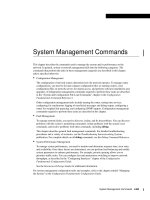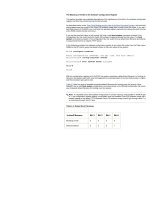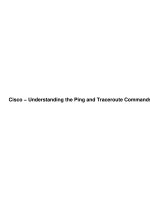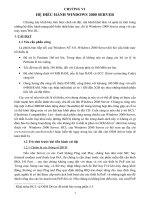Tài liệu Quản trị mạng Understanding the Ping and Traceroute Commands
Bạn đang xem bản rút gọn của tài liệu. Xem và tải ngay bản đầy đủ của tài liệu tại đây (45.35 KB, 20 trang )
Cisco − Understanding the Ping and Traceroute Commands
Table of Contents
Understanding the Ping and Traceroute Commands......................................................................................1
Introduction..............................................................................................................................................1
The Ping Command.................................................................................................................................1
Why Can't I Ping?....................................................................................................................................5
Routing Issue..............................................................................................................................5
Interface Down...........................................................................................................................7
Access−list Command................................................................................................................9
Address Resolution Protocol (ARP) Issue..................................................................................9
Delay.........................................................................................................................................11
Correct Source Address............................................................................................................11
The Traceroute Command.....................................................................................................................13
Performance...........................................................................................................................................15
Using the Debug Command...................................................................................................................16
Related Information ..............................................................................................................................18
Cisco − Understanding the Ping and Traceroute Commands
i
Understanding the Ping and
Traceroute Commands
Introduction
The Ping Command
Why Can't I Ping?
Routing Issue
Interface Down
Access List Command
ARP Issue
Delay
Correct Source Address
The Traceroute Command
Performance
Using the Debug Command
Related Information
Introduction
This document illustrates the use of the ping and traceroute commands. With the aid of some
debug commands, this document captures a more detailed view of how these commands work.
Note: Enabling any debug on a production router may cause serious problems. We recommend that you
carefully read Using the Debug Command before issuing debug commands.
In this document, we use the basic configuration below as a basis for our examples:
The Ping Command
The ping command (which stands for "Packet Internetwork Groper") is a very common method for
troubleshooting the accessibility of devices. It uses a series of Internet Control Message Protocol (ICMP)
Echo messages to determine:
if a remote host is active or inactive, and•
the round−trip delay in communicating with the host.•
The ping command first sends an echo request packet to an address, then waits for a reply. The ping is
Cisco − Understanding the Ping and Traceroute Commands
successful only if:
the echo request gets to the destination, and•
the destination is able to get an echo reply back to the source.•
For all the options about this command, see "Ping" under Troubleshooting Commands.
Below is an output example using the ping command and enabling some debug commands:
Router1#debug ip packet detail
IP packet debugging is on (detailed)
Router1#ping 12.0.0.2
Type escape sequence to abort.
Sending 5, 100−byte ICMP Echos to 12.0.0.2, timeout is 2 seconds:
!!!!!
Success rate is 100 percent (5/5), round−trip min/avg/max = 4/6/8 ms
Router1#
5d02h: IP: s=12.0.0.1 (local), d=12.0.0.2 (Serial0/0), len 100, sending
5d02h: ICMP type=8, code=0
!−−− This is the ICMP packet 12.0.0.1 sends to 12.0.0.2. ICMP type=8 corresponds to the
!−−− echo message.
5d02h: IP: s=12.0.0.2 (Serial0/0), d=12.0.0.1 (Serial0/0), Len 100, rcvd 3
5d02h: ICMP type=0, code=0
!−−− This is the answer we get from 12.0.0.2. ICMP type=0 corresponds to the
!−−− echo reply message.
The table below lists possible ICMP type values.
ICMP Type Literal
0 echo−reply
3 destination unreachable
code 0 = net unreachable
1 = host unreachable
2 = protocol unreachable
3 = port unreachable
4 = fragmentation needed and DF
set
5 = source route failed
Cisco − Understanding the Ping and Traceroute Commands
4 source−quench
5 redirect
code 0 = redirect datagrams for the network
1 = redirect datagrams for the
host
2 = redirect datagrams for the
type of service and network
3 = redirect datagrams for the
type of service and host
6 alternate−address
8 echo
9 router−advertisement
10 router−solicitation
11 time−exceeded
code 0 = time to live exceeded in transit
1 = fragment reassembly time
exceeded
12 parameter−problem
13 timestamp−request
Cisco − Understanding the Ping and Traceroute Commands
14 timestamp−reply
15 information−request
16 information−reply
17 mask−request
18 mask−reply
31 conversion−error
32 mobile−redirect
The table below lists the possible output characters from the ping facility:
IP Ping Test Characters
Character Description
! Each exclamation point indicates receipt of a
reply
. Each period indicates the network server timed
out while waiting for a reply
U
Cisco − Understanding the Ping and Traceroute Commands
A destination unreachable error PDU was
received
Q Source quench (destination too busy)
M Could not fragment
? Unknown packet type
& Packet lifetime exceeded
Why Can't I Ping?
If you are not able to successfully ping to an address, some of the causes may be:
Routing Issue
The following are examples of unsuccessful ping attempts, determining the problem, and what to do to
resolve the problem:
Let's try to ping Router4 from Router1:
Router1#ping 34.0.0.4
Type escape sequence to abort.
Sending 5, 100−byte ICMP Echos to 34.0.0.4, timeout is 2 seconds:
.....
Success rate is 0 percent (0/5)
Let's have a closer look at what has happened:
Router1#debug ip packet
IP packet debugging is on
Router1#ping 34.0.0.4
Type escape sequence to abort.
Sending 5, 100−byte ICMP Echos to 34.0.0.4, timeout is 2 seconds:
5d21h: IP: s=12.0.0.1 (local), d=34.0.0.4, Len 100, unroutable.
5d21h: IP: s=12.0.0.1 (local), d=34.0.0.4, Len 100, unroutable.
5d21h: IP: s=12.0.0.1 (local), d=34.0.0.4, Len 100, unroutable.
5d21h: IP: s=12.0.0.1 (local), d=34.0.0.4, Len 100, unroutable.
5d21h: IP: s=12.0.0.1 (local), d=34.0.0.4, Len 100, unroutable.
Success rate is 0 percent (0/5)
Cisco − Understanding the Ping and Traceroute Commands
Since no routing protocols are running on Router1, it doesn't know where to send its packet and we get an
"unroutable" message.
Now let's add a static route:
Router1#configure terminal
Enter configuration commands, one per line. End with CNTL/Z.
Router1(config)#ip route 0.0.0.0 0.0.0.0 Serial0/0
We now have:
Router1#ping 34.0.0.4
Type escape sequence to abort.
Sending 5, 100−byte ICMP Echos to 34.0.0.4, timeout is 2 seconds:
U.U.U
Success rate is 0 percent (0/5)
6d03h: IP: s=12.0.0.1 (local), d=34.0.0.4 (Serial0/0), Len 100, sending
6d03h: ICMP type=8, code=0
6d03h: IP: s=12.0.0.2 (Serial0/0), d=12.0.0.1 (Serial0/0), Len 56, rcvd 3
6d03h: ICMP type=3, code=1
6d03h: IP: s=12.0.0.1 (local), d=34.0.0.4 (Serial0/0), Len 100, sending
6d03h: ICMP type=8, code=0
6d03h: IP: s=12.0.0.1 (local), d=34.0.0.4 (Serial0/0), Len 100, sending
6d03h: ICMP type=8, code=0
6d03h: IP: s=12.0.0.2 (Serial0/0), d=12.0.0.1 (Serial0/0), Len 56, rcvd 3
6d03h: ICMP type=3, code=1
6d03h: IP: s=12.0.0.1 (local), d=34.0.0.4 (Serial0/0), Len 100, sending
6d03h: ICMP type=8, code=0
Now let's see what is wrong on Router2:
Router2#
21:56:04: IP: s=12.0.0.1 (Serial1), d=34.0.0.4, Len 100, unroutable
21:56:04: ICMP type=8, code=0
21:56:04: IP: s=12.0.0.2 (local), d=12.0.0.1 (Serial1), Len 56, sending
21:56:04: ICMP type=3, code=1
21:56:04: IP: s=12.0.0.1 (Serial1), d=34.0.0.4, Len 100, unroutable
21:56:04: ICMP type=8, code=0
21:56:06: IP: s=12.0.0.1 (Serial1), d=34.0.0.4, Len 100, unroutable
21:56:06: ICMP type=8, code=0
21:56:06: IP: s=12.0.0.2 (local), d=12.0.0.1 (Serial1), Len 56, sending
21:56:06: ICMP type=3, code=1
21:56:06: IP: s=12.0.0.1 (Serial1), d=34.0.0.4, Len 100, unroutable
21:56:06: ICMP type=8, code=0
21:56:08: IP: s=12.0.0.1 (Serial1), d=34.0.0.4, Len 100, unroutable
21:56:08: ICMP type=8, code=0
21:56:08: IP: s=12.0.0.2 (local), d=12.0.0.1 (Serial1), Len 56, sending
21:56:08: ICMP type=3, code=1
Router1 is correctly sending its packets to Router2, but Router2 doesn't know how to access address 34.0.0.4.
Router2 sends back an "unreachable ICMP" message to Router1.
Now let's enable Routing Information Protocol (RIP) on Router2 and Router3:
Router2#
router rip
network 12.0.0.0
Cisco − Understanding the Ping and Traceroute Commands









